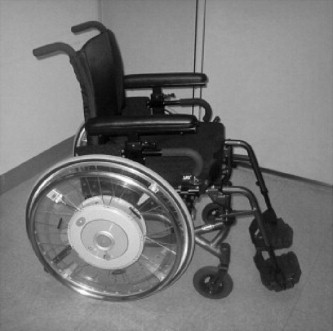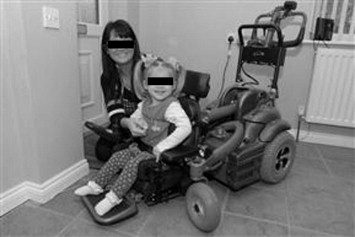Mobility-assistive technologies allow patients with neuromuscular disease to interact with peers and the community. In children, they also serve to facilitate development. Lack of access to appropriate assistive technology, especially in regards to mobility, can have adverse developmental consequences. There are multiple options for mobility devices and methods for their control. These devices can be integrated with other electronics to facilitate the control of a variety of devices in the environment. The clinician should assess which devices are best based on the patient’s, caregivers’, and medical team’s goals.
- •
Children as young as 24 months can learn to safely operate a power wheelchair.
- •
Power-assist wheelchairs are useful for nonambulatory patients with neuromuscular disease (NMD) with mild upper limb weakness.
- •
The NMD multidisciplinary team needs to consider the specific neuromuscular disease and plan for appropriate progression affecting the need for modifiable mobility devices.
- •
Proper seating and positioning is critical to maximize function and the optimal use of mobility-assistive technologies.
- •
Electronic control systems are available to integrate with environmental control systems and computer access.
Introduction
Mobility-assistive technology is essential for maintaining the function of individuals with severe or progressive neuromuscular disease (NMD). The types of devices required change as the disease progresses. In the pediatric population, despite disease progression, there can still be developmental progress in a variety of cognitive and social domains. Without proper accommodations for goal-directed independent mobility whereby children can explore and affect their environment, there can be delays in cognitive and social development caused by mobility impairment. These devices need to be able to accommodate and adapt to the individual’s needs.
As more specialized functions are required, the financial cost also increases. It is important for the clinician, therapist, family, and patient to be aware of what durable medical equipment coverage is available as well as the qualification for such equipment based on medical necessity and documentation requirements imposed by their specific funding source. Coverage, qualification based on medical necessity, and documentation requirements vary by payer source and region. It is also important to consider charitable resources that can provide assistance when needed.
Required considerations for the proper evaluation of mobility-assistive technology include a physical, visual, and cognitive assessment. The evaluation frequency needs to be completed based on the functional status of the patient and the rate and degree of disease progression. Physical, occupational, and speech therapists can be involved to provide insights regarding the interface between the patient and the device. These insights may influence the decision to choose a particular product rather than another. Overall, there needs to be a patient-centered team approach when addressing the needs of this patient population to determine what type of device is most appropriate.
Mobility-assistive technology in the pediatric NMD population
Mobility-assistive technology has multiple roles. Besides providing home and community accessibility, it plays a role in the child’s overall development. These devices facilitate learning and social development. These devices also need to be tailored to the child’s developmental needs. Failure to provide access to the appropriate devices limits children’s ability to achieve their full potential.
Butler published a case series of 8 children mostly with spinal muscular atrophy (SMA) type II. The youngest child who was able to achieve safe and independent power mobility was 24 months old. One child began learning the task of operating a powered mobility device at 20 months of age. These children were all of normal intelligence. Common diagnoses considered for early power mobility include SMA type II, congenital muscular dystrophies, congenital myopathies, congenital myasthenic syndromes, and Charcot-Marie-Tooth (CMT) type 3 or Dejerine-Sottas disease. Butler and colleagues subsequently studied the effects of powered mobility on the development of young children with locomotor disability. They showed that learning powered mobility at 24 months had benefits on the frequency of self-initiated interaction with objects, spatial exploration, and communication with caregivers.
Mobility-assistive technology in the pediatric NMD population
Mobility-assistive technology has multiple roles. Besides providing home and community accessibility, it plays a role in the child’s overall development. These devices facilitate learning and social development. These devices also need to be tailored to the child’s developmental needs. Failure to provide access to the appropriate devices limits children’s ability to achieve their full potential.
Butler published a case series of 8 children mostly with spinal muscular atrophy (SMA) type II. The youngest child who was able to achieve safe and independent power mobility was 24 months old. One child began learning the task of operating a powered mobility device at 20 months of age. These children were all of normal intelligence. Common diagnoses considered for early power mobility include SMA type II, congenital muscular dystrophies, congenital myopathies, congenital myasthenic syndromes, and Charcot-Marie-Tooth (CMT) type 3 or Dejerine-Sottas disease. Butler and colleagues subsequently studied the effects of powered mobility on the development of young children with locomotor disability. They showed that learning powered mobility at 24 months had benefits on the frequency of self-initiated interaction with objects, spatial exploration, and communication with caregivers.
Manual wheelchairs
Patients with milder or more slowly progressive NMD can often use a manual wheelchair as their primary mode of mobility. Decreased exercise tolerance either caused by primary muscle or cardiopulmonary effects of the disease needs to be taken into consideration in determining what type of manual wheelchair would be most appropriate.
Manual wheelchairs can be divided into independent versus dependent devices. Independent manual wheelchairs (eg, lightweight or ultralightweight manual wheelchairs) can be used early in the disease to provide some level of energy conservation for community mobility for patients who may be able to ambulate only household distances. Dependent manual wheelchairs (eg, tilt-in-space manual wheelchairs) may become necessary as the disease progresses and patients are no longer able to perform any type of independent mobility or cognitive dysfunction limits their ability to use forms of independent mobility. Dependent manual wheelchairs are pushed by the caregiver. Dependent-type wheelchairs, although heavier, can better accommodate additional devices such as adaptive communication devices, ventilators, and feeding pumps. These types of wheelchairs can serve as a backup manual wheelchair for primary power wheelchair users.
A manual wheelchair should be ordered early during the disease process to be used as a community mobility device for household ambulators that may require a mobility device for community mobility. Obtaining a manual wheelchair that can later serve as a backup chair when powered mobility is initiated should be considered if powered mobility is anticipated in the future. The subsequent power wheelchair is approved because of medical necessity caused by the disease progression. It is important to have a backup form of mobility in case of emergencies when access to electricity is limited or absent.
Geared and power-assist wheelchairs and mobility devices
Power-assist and geared devices are more appropriate for those who have a more slowly progressive disease. These devices can be adjusted to reduce the physical effort and endurance required to self-propel. Since the power-assist devices are attached to a manual wheelchair frame, they are lighter and more portable than a traditional power wheelchair. Some patients may choose this option to try to reduce the stigma of being in a larger power wheelchair. Others use these devices because they have suboptimal proximal shoulder girdle strength to propel standard wheelchairs for long distances. Power-assist wheels or rims ( Fig. 1 ) have an electrical motor attached to the wheel. The rim senses the push and turns the wheel at an accelerated rate. These wheels can be interchanged with traditional wheels.

Geared devices use mechanical means to reduce the force required to propel a wheelchair. They allows the user to modify the gearing of either levers or the hand rim to propel the wheel at a different ratio than a standard hand rim. They can be considered if an individual lives or works in an area where access to electricity for long periods of time is limited. Users often interchange them with standard hand rims when needed.
Scooters
Power Scooters can be a good option for patients who are in a transition period between ambulation and full-time wheelchair use. They can also be used for more slowly progressive diseases in which fatigue is one of the major symptoms. Patients who use scooters must have good arm strength, trunk balance, and core strength to transition in and out of the scooter. Patients with progressive disease processes that start more distally, such as hereditary sensory motor neuropathy or slowly progressive distal myopathies, may be good candidates for scooters. For ambulators, scooters are also easier to transfer to and from because of the relatively elevated seat height in comparison with a standard wheelchair. In addition, the seats often rotate 90° to facilitate transitions from sitting to standing.
Power-assistive mobility devices
Power mobility is the primary mode of mobility for many patients with NMD, especially at the later stages of a disease process. Power mobility requires the least strength. Patients who may be dependent for most activities of daily living are still capable of independent mobility. Power mobility must also be considered for patients in whom fatigue and lack of endurance are significant components of the disease process. Energy conservation allows patients to be able to focus more on activities of daily living and vocational activities instead of exhausting all energy for mobility.
Complex power wheelchairs are commonly used in neuromuscular disorders. A complex power wheelchair is modifiable in virtually every aspect including the seating system, accessories such as armrests and headrests, as well as the control interface and switches. Some models have a seat-to-floor mode option so that children can participate in age-appropriate floor activities ( Fig. 2 ). It also allows increased independence for those individuals who have the strength to perform floor-to-seat transfers. Power chairs can be made to accommodate other devices, such as a tray for mounting a mechanical ventilator or biphasic positive airway pressure machine.











